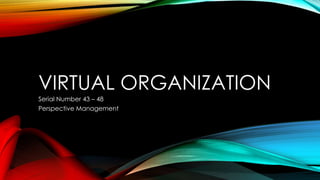
Virtual organization
- 1. VIRTUAL ORGANIZATION Serial Number 43 – 48 Perspective Management
- 2. INTRODUCTION • Its origin • Does not have a physical presence • Coming together of independent firms • Appear to be unified • Highest quality, lowest price, timely manner • Multi-actor system – humans and computers
- 3. CHARACTERISTICS 1. Outsourcing 2. Connected via Software – BOINC Berkley Open Infrastructure for Network Computing Grid Computing CPU Scavenging 3. Business Without Walls No User Interface Infrastructure in terms of tangibility. 4. Temporary Existence
- 4. TYPES Basic Types of Virtual Organization • Organization Network - Work organization that consists of several autonomous organizations and that crosses boundaries of formal organization. • Network Organization - Work organization of humans and computer actors that cooperate dispersed in place and time. • Objective Virtual Organization - Formal organization with humans and virtual actors in which virtual actors replace humans • Subjective Virtual Organization - Artifact organization within the virtual domain that influences participating humans.
- 5. TYPES ( CONTD. ) Composite Types of Virtual Organization • Front-Office / Back-Office- Optimization of attention paid to customer in front office. Optimization of processing speed, efficiency, quality in back office • The E-commerce Organization - Is a combination of a virtual shop with an efficient system of order processing.
- 6. TRENDS 1.Pace 2.Cost 3.Personalization 4.Globalization
- 7. ADVANTAGES •Modern management techniques and methods •Customer Satisfaction and market wants •Reduced Organizational Cost •Customization
- 8. DISADVANTAGES •Peer to Peer basis •Geographical and Legal barriers •Security system •Confidentiality and privacy
